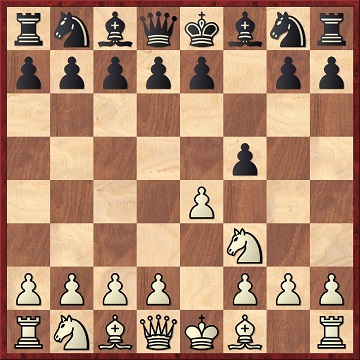
Edward Winter

Chess Enterprises have published Forty Years at the Top (‘John Curdo’s Chess Career’), edited by Bob Sanchez (Coraopolis, 1988) ... Game 95 (pages 89-90) is what ‘has to be the most amusing game I’ve ever played. It rates high on my list of swindles.’ The punctuation is Curdo’s.
John Dunning – John Curdo
Leominster, 1 April 1979
Lisitsin’s Gambit
1 Nf3 f5 2 e4 fxe4 3 Ng5 e5 4 d3 e3 5 Bxe3 Nc6 6 Be2 Nf6 7 O-O Be7 8 f4 Nd5?? 9 Bh5+ g6 10 Nxh7! Kf7! 11 f5 Nxe3 12 fxg6+ Ke6! 13 Qf3 Nxf1 14 Qf7+ Kd6 15 Nc3 Nb4

16 a3 Ne3 17 axb4 c6 18 g7 Rg8 19 Ne4+ Kc7 20 Nef6 Rxg7 21 Qxg7 Nxc2 22 Rf1 Nxb4 23 Ne8+ Kb6 24 Qxe5 Nxd3 25 Qg3 Bc5+ 26 Kh1 Nb4 27 Nhf6 d5 28 Bg4 a5 29 h4 Bd4 30 Bxc8 Rxc8 31 h5 Bxf6 32 Nxf6 Qh8 33 Qg6 d4 34 h6 d3 35 Qg7 d2 36 Rd1 Nd5! 37 Nxd5+ cxd5 38 Rxd2 Qxg7 39 hxg7 Rg8 40 Rxd5 Drawn.
(1821)
The moves 1 Nf3 f5 2 e4 (‘Lisitsin’s Gambit’) occurred in a forgotten game played about a decade before Lisitsin himself ‘introduced’ the line. The game Alfred Emil Wolf v Max Weiss, Vienna, 12 May 1923, began 1 Nf3 f5 2 e4 fxe4 3 Ng5 Nf6 4 d3 e3 5 fxe3 e5 6 Be2 d5 7 O-O Be7 8 Bh5+ g6 9 Nc3 O-O 10 Bf3 c6 11 e4 d4 and was drawn at move 44.
Wolf annotated the game on pages 162-164 of the August 1923 Wiener Schachzeitung, the issue which announced his death. The son of the master Siegfried Reginald Wolf, he died on 2 August 1923 at the age of 23 from a fall in the Swiss mountains (Jungfrau). [See too C.N. 6352 below.] Page 338 of Bachmann’s Schachjahrbuch 1923 also credited to him the introduction of the Landstrasse Gambit (1 Nf3 d5 2 c4).
Another 1 Nf3 f5 2 e4 game of the 1920s appeared on pages 130-131 of the August-September 1926 issue of Časopis Československých Šachistů:
A. Hochwald – V. Berger
Kyjov, 26 August 1926
Lisitsin’s (Wolf?) Gambit
1 Nf3 f5 2 e4 fxe4 3 Ng5 Nf6 4 d3 exd3 5 Bxd3 e5 6 Nxh7 d5 4 Bg6+ Ke7 8 Bg5 Be6 9 Nc3 c6 10 Qe2 Nd7 11 O-O Qa5 12 Rfe1 Kd8 13 Nxf6 gxf6 14 Bxf6+ Be7 15 Bxh8. Black resigned at move 21, but the magazine did not give the remaining moves.
(Kingpin, 1998)
From Maarten de Zeeuw (Rotterdam, the Netherlands):
‘There was a forerunner to Lisitsin’s Gambit. S. Freiman-Rubinstein, Vilnius, 1912 started 1 f4 e6 2 Nf3 f5 3 e4 d5 4 exd5 exd5 5 d4 Nf6 and 1-0 after 32 moves. After 3…fxe4 4 Ng5, Black would have gained a tempo, as the move f4 seems useless, but in Freiman-Bogoljubow, St Petersburg, 1914 he was not able to take advantage (4…Nf6 5 d3 h6 6 Nxe4 d5 7 Nf2 and 1-0 after 22 moves).’
Regarding the first of these games, the move-order given by our correspondent is confirmed by various contemporary sources, but page 241 of Akiba Rubinstein: Uncrowned King by J. Donaldson and N. Minev stated that the game began 1 f4 f5 2 Nf3 e6 3 e4 d5 exf5 4 exf5 exf5. An alternative spelling often seen for White’s name is Freymann.
(Kingpin, 2000)
Under the title ‘The Sincerest Form of Flattery?’ John Donaldson wrote an article on pages 24-25 of Inside Chess, 3 May 1993 which began as follows:
‘Examples of plagiarism are not unknown in chess literature, but Raymond Keene has set a new standard for shamelessness in his recent work, The Complete Book of Gambits (Batsford, 1992). ... Unfortunately, Mr Keene has done nothing less than steal another man’s work and pass it off as his own.
A glance at pages 128-132 of his recent book, The Complete Book of Gambits, and a comparison with my two-part article on Lisitsin’s Gambit, which appeared in Inside Chess, Volume 4, Issue 3, pages 25-26, and Issue 4, page 26, early in 1991, reveals that not only did Mr Keene have nothing new to say about Lisitsin’s Gambit, he could hardly be bothered to change any of the wording or analysis from the articles that appeared in Inside Chess other than to truncate them a bit. What’s more, no mention of the original source was given in The Complete Book of Gambits, misleading the reader as to the originality of Mr Keene’s work.
Just how blatant was the plagiarism? Virtually every word and variation in the four and a half pages devoted to Lisitsin’s Gambit in Keene’s book was stolen.’
(2966)
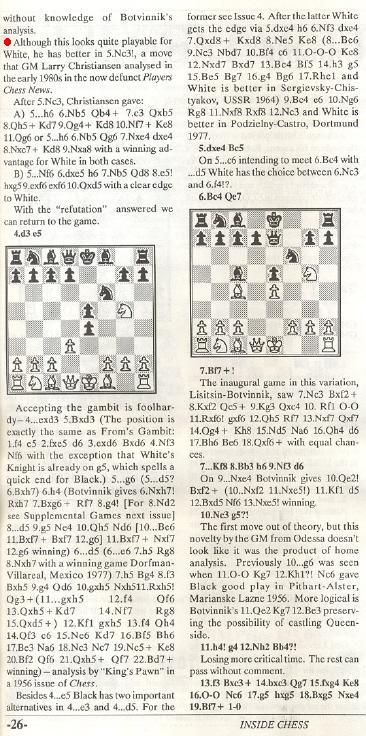
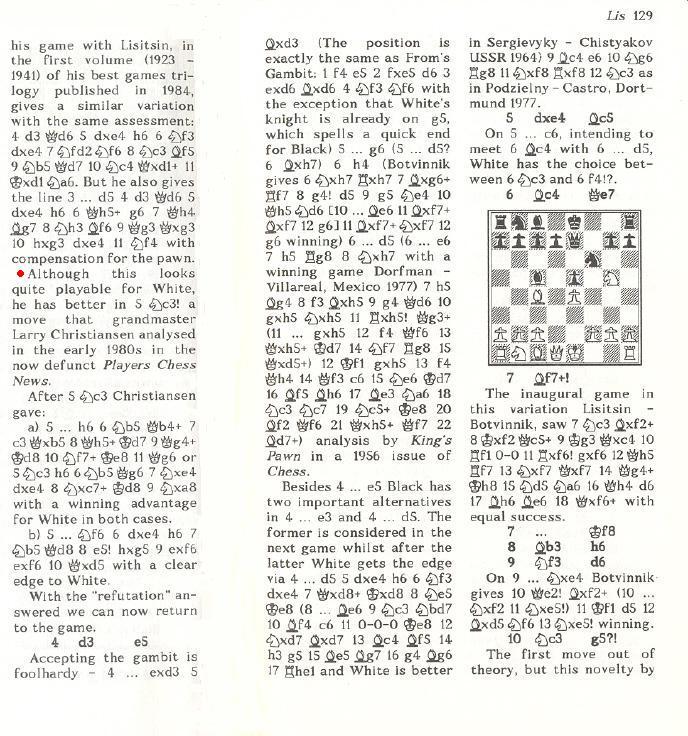
Left: part of John Donaldson’s article in Inside Chess. Right: from pages 128-129 of Raymond Keene’s subsequent The Complete Book of Gambits.
For further details, see Copying.
The earliest specimen of Lisitsin’s Gambit which we have noted:
Alfred Emil Wolf – Max Weiss
Vienna, 12 May 1923
Lisitsin’s Gambit
1 Nf3 f5 2 e4 fxe4 3 Ng5 Nf6 4 d3 e3 5 fxe3 e5 6 Be2 d5 7 O-O Be7 8 Bh5+ g6 9 Nc3 O-O 10 Bf3 c6 11 e4 d4 12 Ne2 c5 13 c3 Nc6 14 Qb3+ Kg7 15 Ne6+ Bxe6 16 Qxe6 Qd7 17 Bg4 Qxe6 18 Bxe6 Rad8 19 cxd4 Nxd4 20 Nxd4 Rxd4 21 Rf3 Nh5 22 Rxf8 Bxf8 23 Bc4 Rd6 24 b4 Nf4 25 bxc5 Rd7 26 Bxf4 exf4 27 Bd5 Bxc5+ 28 Kf1 Kf6 29 Rc1 b6 30 Ke2 Ke5 31 Rc4 g5 32 Kd2 g4 33 Kc3 Rc7 34 Kd2 Be3+ 35 Ke2 Rxc4 36 Bxc4 h5 37 Bf7 h4 38 Bh5 Bg1 39 h3 gxh3 40 gxh3 Kd4 41 Bf7 b5 42 Bb3 a5 43 Kf3 Bh2 44 Bf7 Drawn.
Source: Wiener Schachzeitung, August 1923, pages 162-164.
Less than three months after playing the game, Wolf was dead, aged 23. His annotations were included in the Wiener Schachzeitung:
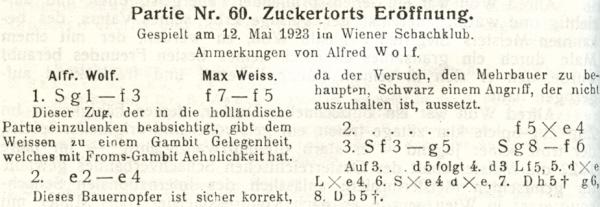
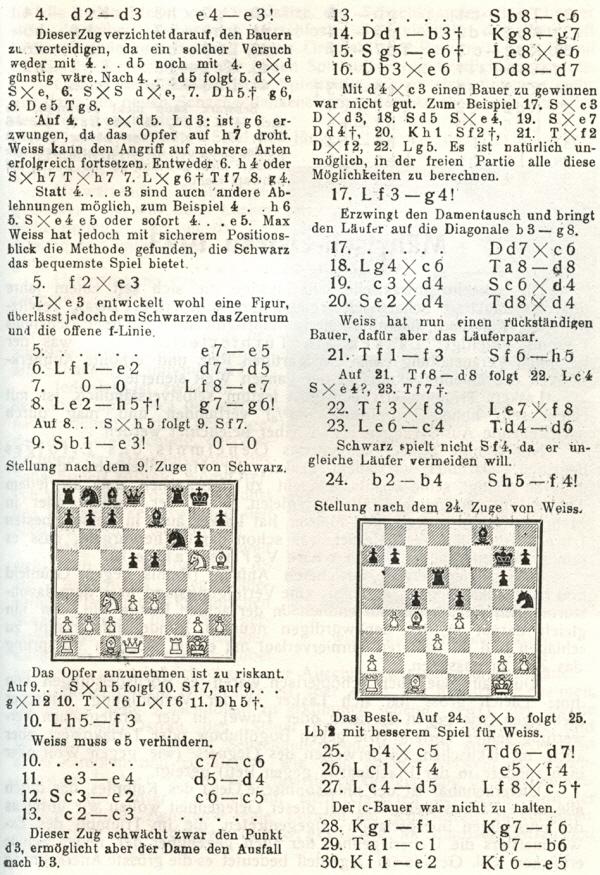
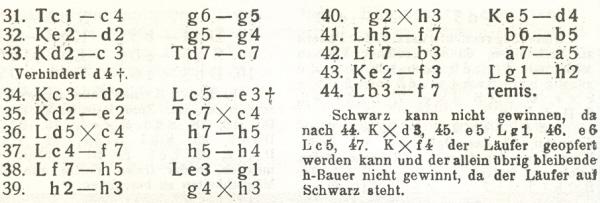
To the Chess Notes main page.
To the Archives for other feature articles.
Copyright: Edward Winter. All rights reserved.